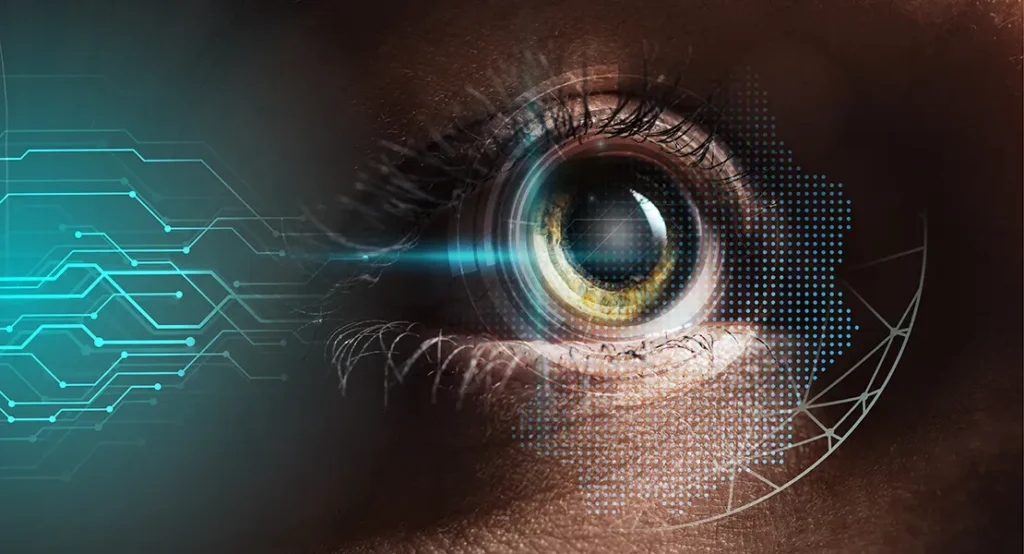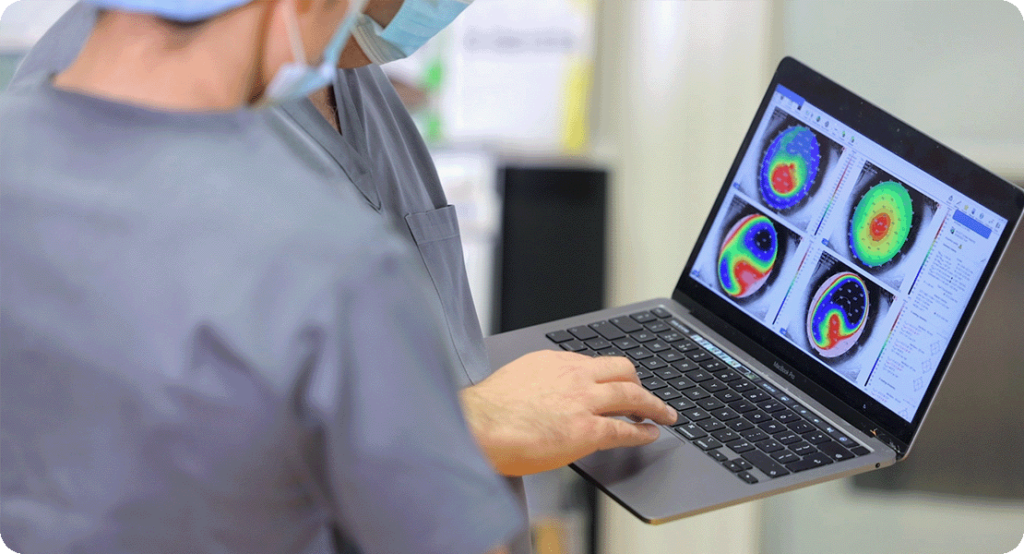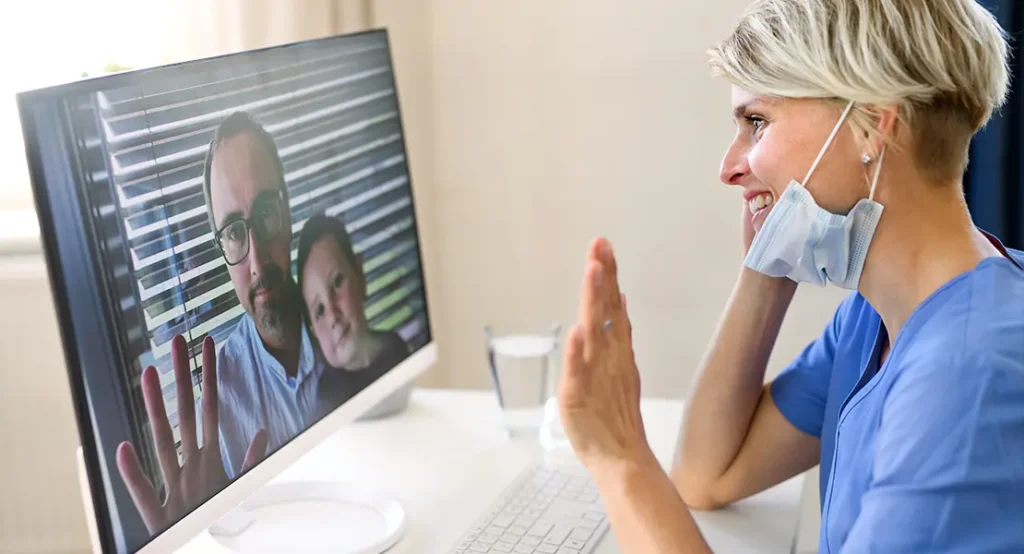Artificial Intelligence (AI) is increasingly becoming a key player in healthcare innovation, revolutionising how diseases are detected, monitored and managed. In the realm of ophthalmology, where detailed visual assessments and timely diagnoses are critical, AI offers a powerful set of tools. Cataracts, a leading cause of reversible blindness, represent a domain where AI has already begun to demonstrate clear utility. With populations ageing globally, the need for efficient, accurate, and accessible cataract diagnostics has never been more urgent.
The conventional process of diagnosing cataracts involves a combination of slit-lamp biomicroscopy, refraction, and visual acuity testing, which require both time and the presence of trained personnel. These traditional methods, although effective, are often limited by geographical disparities in access to ophthalmic care. In many regions, patients may wait months for a routine eye examination, during which time cataracts can progress and impact quality of life. AI-driven diagnostic tools aim to fill this service gap, offering rapid assessment and triage that can be deployed in primary care or even in remote settings.

AI technology, particularly machine learning (ML) and deep learning (DL), excels at recognising patterns in visual data. These capabilities make it ideally suited for ophthalmology, a field heavily reliant on imaging. In cataract diagnosis, AI models can be trained on large datasets of ocular images to identify early signs of lens opacity, determine the type of cataract present, and even grade its severity. These systems operate without fatigue, can process vast amounts of data quickly, and can function with minimal user training.
As these AI tools mature, their potential applications are expanding beyond mere detection. Developers are now working on predictive models that may forecast cataract development based on patient demographics, systemic health data, and longitudinal imaging. These advancements could fundamentally shift cataract care from reactive treatment to proactive management, paving the way for a more personalised and preventive approach in eye health.
Understanding Cataracts and Their Diagnostic Challenges
Cataracts form when proteins in the eye’s lens begin to break down and clump together, causing the lens to become cloudy. This process usually develops gradually and can affect one or both eyes. As the cataract grows, it scatters and blocks light entering the eye, leading to symptoms such as blurred vision, glare sensitivity, and dullness of colours. While age-related cataracts are most common, the condition can also occur secondary to trauma, radiation exposure, certain medications, or underlying health conditions like diabetes.
Diagnosing cataracts requires a nuanced clinical evaluation. Typically, an ophthalmologist will conduct a series of tests including a slit-lamp examination, which allows detailed visualisation of the anterior eye structures. Other tools like tonometers and retinal imaging devices may also be used to rule out coexisting conditions. These diagnostic procedures demand not only equipment but also clinical expertise, both of which may be lacking in underserved areas. In such settings, cataracts can go undiagnosed or be detected too late, resulting in irreversible visual disability.
Moreover, the symptoms of cataracts can be easily mistaken for other ocular or neurological conditions, particularly in early stages. Patients may complain of vision problems that are attributed to refractive errors or presbyopia, delaying accurate diagnosis. Even when detected, the decision to proceed with surgery can be subjective, as not all patients experience functional impairment to the same degree. Consequently, there is a clear need for standardised, objective methods to identify cataracts and assess their impact on vision.

This is where AI offers a transformative solution. By providing consistent image analysis and quantifying lens opacity using set parameters, AI can reduce diagnostic variability. It can also assist general practitioners or optometrists in making more accurate referrals to ophthalmologists, thus improving patient pathways. The introduction of AI into cataract diagnosis could dramatically increase early detection rates, particularly in health systems where ophthalmic care is overburdened or inaccessible.
The Role of AI in Cataract Detection
AI systems designed for cataract detection typically rely on image-based machine learning, where large numbers of eye images are used to train algorithms to detect anomalies. These algorithms, especially convolutional neural networks (CNNs), are highly effective at identifying visual features such as lens clouding, asymmetry, and the precise location of cataract involvement. Once trained, these models can rapidly and accurately evaluate new images, flagging any suspected cataracts for further review.
One of the main strengths of AI in this context is its scalability. A single AI system can analyse thousands of images in a short timeframe, making it particularly valuable for high-volume screening initiatives. Whether deployed in community clinics, mobile screening units or telemedicine hubs, AI can offer consistent assessments without requiring the constant presence of a specialist. This ensures broader coverage, especially in regions with few ophthalmologists per capita.
Beyond detection, AI can also assist in grading the severity of cataracts. Traditional grading scales, such as the Lens Opacities Classification System (LOCS), are subjective and depend heavily on the clinician’s judgement. AI-based models, however, can standardise the grading process by measuring lens density and opacification using pixel-based analysis. This removes variability, ensuring that surgical referrals are made based on quantifiable data rather than subjective impressions.
Importantly, AI is not intended to act in isolation. These tools are most effective when integrated into a broader clinical workflow, where the AI acts as a decision-support system. The ophthalmologist still makes the final judgement, but with the added benefit of AI-generated insights. This hybrid model enhances diagnostic confidence, reduces human error, and allows specialists to focus their time on complex cases that require detailed evaluation and planning.
Smartphone-Based AI Screening Tools
In recent years, the use of smartphones for eye screening has grown rapidly, driven by improvements in camera resolution and computational power. With the addition of low-cost lens attachments and imaging apps, smartphones can now capture high-quality anterior segment photos. AI algorithms can be embedded directly into these devices or used in cloud-based systems, enabling point-of-care cataract screening in community settings, pharmacies, or even patients’ homes.
The primary advantage of smartphone-based screening is accessibility. These tools can be used by healthcare workers with minimal training, dramatically increasing the reach of eye care services. In low-resource environments where clinical infrastructure is sparse, such tools may represent the only viable option for large-scale screening. They can be particularly impactful in identifying cataracts early in rural populations, enabling timely intervention and reducing the burden of blindness.
Several pilot programmes and research studies have shown that smartphone-AI combinations can match or even outperform traditional screening in terms of sensitivity and specificity. These systems are capable of flagging suspected cataracts and recommending referral for surgical evaluation. Some platforms also include features for capturing patient data, creating reports, and integrating with telemedicine systems, further enhancing their usability in the field.
Despite their promise, these tools do come with limitations. Image quality can vary depending on ambient lighting, user technique, and device model, which can affect diagnostic accuracy. Ensuring proper training and standardisation is therefore essential. Nonetheless, as smartphone technology continues to evolve, and as AI algorithms become more robust, these mobile platforms are likely to play a central role in global cataract prevention strategies.
Integration with Teleophthalmology
The combination of AI and teleophthalmology is proving to be a powerful approach in modern eye care, especially for cataract screening and diagnosis. By linking remote patients with centralised specialist services through digital platforms, teleophthalmology bridges the gap between accessibility and expertise. When AI is integrated into this model, it can automatically screen images for cataracts before a specialist even reviews them, significantly improving efficiency and reducing delays in diagnosis.

In practical terms, this might involve capturing anterior segment images at a local clinic or mobile screening camp and uploading them to a cloud-based system. The AI model analyses the images almost instantly and flags those showing signs of cataract. A remote ophthalmologist then reviews the flagged cases and recommends appropriate next steps. This streamlined process reduces the burden on specialists and speeds up the referral and treatment cycle for patients.
One major advantage of this integration is the potential to triage patients more effectively. Rather than referring all patients with vision complaints to secondary care, AI can help prioritise those who truly need surgical assessment. This reduces unnecessary hospital visits and ensures that those requiring intervention are identified and treated sooner. For overstretched public health systems, this form of intelligent triage is an important development in resource management.
Furthermore, integrating AI with teleophthalmology opens doors to more continuous care. Patients with early cataract changes who may not yet require surgery can be monitored over time, with follow-up images taken remotely. The AI can track the progression of the condition and trigger alerts when changes suggest that intervention may be needed. This proactive, data-driven monitoring model supports better long-term outcomes and a more personalised approach to cataract management.
Multi-Disease Detection Capabilities
A growing trend in ophthalmic AI development is the creation of multi-disease detection platforms. These are designed to assess a single ocular image—typically a fundus or slit-lamp photo—for signs of multiple eye conditions at once, including cataracts, diabetic retinopathy, glaucoma, and macular degeneration. This multi-tasking capability not only improves efficiency but also allows for a more comprehensive understanding of a patient’s ocular health from one point of contact.
For patients, this means fewer appointments and a more complete evaluation in a single session. For clinicians, it streamlines the diagnostic workflow, reduces redundancy, and ensures that co-existing conditions are not missed. In the context of cataracts, this is especially useful because the condition often co-occurs with other diseases in older adults. An AI that can detect cataracts alongside other pathologies ensures holistic care and avoids fragmented treatment pathways.
From a public health perspective, multi-disease detection is a game-changer for mass screening programmes. These AI systems can be deployed in community settings to efficiently identify a range of potentially blinding conditions, prioritising those requiring urgent care. In doing so, they help prevent not only cataract-related vision loss but also damage from other sight-threatening diseases that may go unnoticed during traditional cataract assessments.
While promising, multi-disease AI models do present technical challenges. Each condition requires a different type of analysis, and image features relevant for one disease may interfere with detection of another. Developers must ensure that the algorithms are well-balanced and that diagnostic accuracy is maintained across all target conditions. Continued refinement and validation in diverse patient populations will be critical to the success of these systems on a larger scale.
Regulatory and Ethical Considerations
As AI technologies become more embedded in healthcare workflows, there is growing scrutiny from regulatory authorities regarding their safety, transparency and efficacy. In the UK, the Medicines and Healthcare products Regulatory Agency (MHRA) plays a central role in assessing medical AI tools, ensuring they meet rigorous clinical and ethical standards. Cataract diagnostic tools powered by AI are no exception, and developers must demonstrate robust evidence of accuracy, fairness and clinical benefit.
One key regulatory concern is algorithmic bias. If an AI system is trained predominantly on data from one demographic—say, middle-aged Caucasian patients—it may underperform when used on different populations. This could lead to misdiagnosis or missed cases in minority groups. Addressing such bias requires diverse, representative training datasets and regular algorithm audits, both of which should be mandatory in regulatory approval processes.
Patient consent and data privacy are also essential considerations. AI tools rely on large datasets to function effectively, but the use of medical images and patient information must comply with privacy laws such as the UK General Data Protection Regulation (UK GDPR). Patients need to be informed about how their data is used, stored, and protected. Moreover, the use of anonymised data for model training must be conducted with full transparency and oversight.

Lastly, there are ethical questions about the role of AI in clinical decision-making. While AI can support clinicians, it should not replace human judgement. Clear guidelines must be established about who is responsible for clinical outcomes when AI is involved. Ensuring that patients continue to receive human-centred care, even when technology plays a supporting role, is critical to maintaining trust in medical services.
Limitations and Areas for Improvement
Despite the rapid advances in AI for cataract diagnosis, several important limitations remain. One of the most significant is the issue of image quality. AI algorithms are highly dependent on the clarity and resolution of input images, and their performance may drop significantly if photos are poorly lit, out of focus, or obscured by other ocular conditions. In real-world settings, especially outside specialist clinics, capturing consistent, high-quality images remains a challenge.
Another concern is the generalisability of AI models. Many algorithms are trained on datasets collected from specific geographic or clinical populations, meaning they may not perform equally well when deployed elsewhere. Variations in camera equipment, lighting conditions, and patient demographics can all impact accuracy. To overcome this, there is a need for broader, multi-centre datasets that reflect the diversity of patients and conditions encountered in routine practice.
Integration into clinical systems also presents practical hurdles. For AI to be truly effective, it must function smoothly within existing healthcare infrastructure, including electronic health records (EHRs), diagnostic devices, and referral systems. This requires technical compatibility, robust IT support, and clear clinical protocols. Without these, even the most advanced AI tools may sit unused, their potential unrealised.

Finally, clinicians and patients alike must be trained in how to interact with AI-based systems. Trust in the technology depends on understanding how it works, what its strengths are, and where it might fall short. Education and engagement at all levels—from ophthalmologists to community health workers—will be essential for successful adoption. Continued research, pilot testing, and user feedback will help fine-tune these systems and ensure they truly meet the needs of those they aim to serve.
Conclusion
The integration of Artificial Intelligence into cataract diagnosis marks a significant milestone in the evolution of ophthalmic care. By enhancing accuracy, standardising assessments, and expanding access to underserved populations, AI has already begun to reshape how cataracts are detected and managed. From advanced image analysis to real-time smartphone screening tools, the latest developments are not only improving individual patient outcomes but also supporting broader public health initiatives aimed at reducing preventable blindness.
However, it is essential to recognise that AI is not a standalone solution. Its success depends on how well it is integrated into existing healthcare systems and how responsibly it is deployed. Regulatory oversight, ethical considerations, and continuous validation are all necessary to ensure AI tools remain safe, unbiased, and effective. Moreover, fostering collaboration between technologists and clinicians is crucial to developing tools that are both clinically meaningful and user-friendly.
Despite its limitations, AI has proven its worth as a powerful support tool in cataract care. It enables faster diagnosis, better triage, and more consistent grading, ultimately leading to more timely and appropriate surgical interventions. As the technology continues to evolve, we can expect even more sophisticated applications, including predictive modelling, personalised care pathways, and fully automated screening systems for use in community settings.
Looking ahead, the role of AI in cataract diagnosis will only grow stronger. As datasets become more inclusive and systems become more adaptable, the reach and reliability of AI will improve further. With continued investment, research, and collaboration, AI has the potential to make high-quality eye care accessible to all, regardless of geography or economic status—bringing us closer to a world where preventable blindness becomes a rarity rather than a reality.

